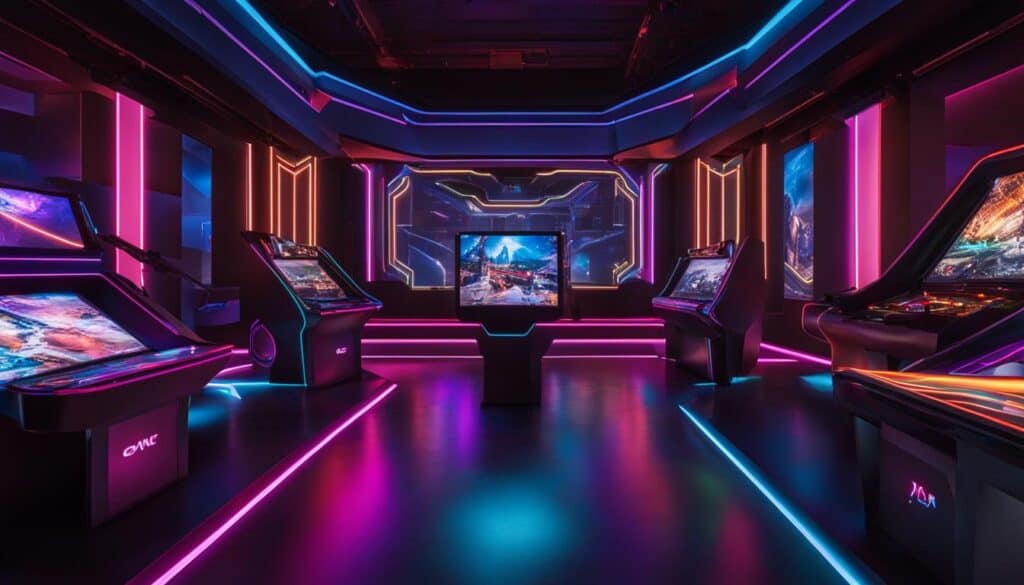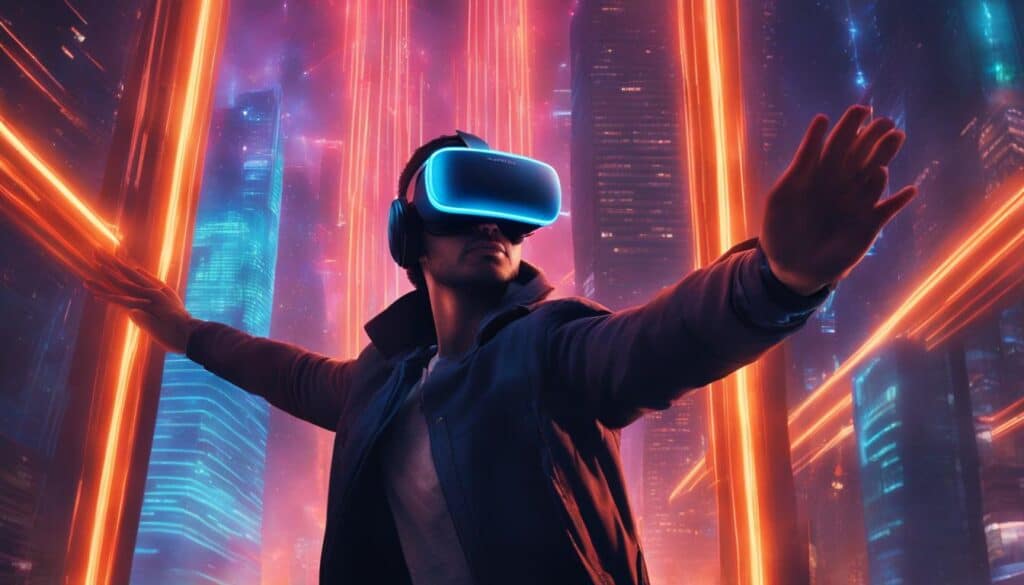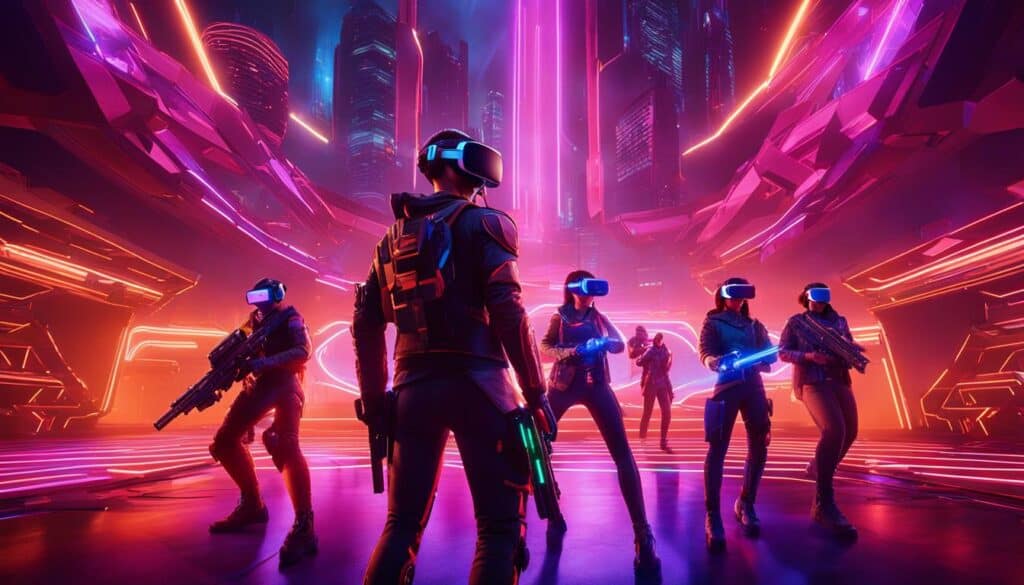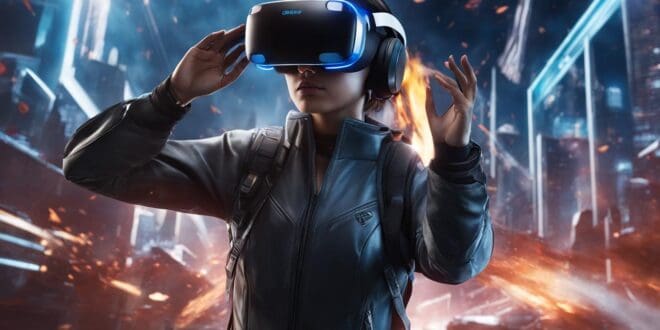Welcome to our exclusive look into the future of virtual reality gaming! In this article, we will dive into the latest trends and innovations that will shape the virtual reality gaming landscape in 2024. From immersive experiences to advancements in technology, get ready to discover the exciting developments that await gamers in the coming year.
Key Takeaways:
- Virtual reality arcades are on the rise, offering gamers a unique and social gaming experience.
- Enhanced graphics and realistic environments will transport players to breathtaking new worlds.
- Haptic feedback and motion capture technology will bring a new level of realism to VR gaming.
- Multiplayer VR experiences will provide immersive and social gaming interactions.
- VR technology is becoming more accessible and affordable, opening up the world of VR to a wider audience.
The Rise of Virtual Reality Arcades

Virtual reality arcades have emerged as a thrilling and social way for gamers to experience the immersive world of VR gaming. These arcades provide cutting-edge VR equipment and a wide selection of games, offering an unparalleled gaming experience that transcends traditional gaming setups. In 2024, we can anticipate an upsurge in the popularity of virtual reality arcades, as more gamers seek out the excitement and camaraderie that these unique venues offer.
What sets virtual reality arcades apart is their ability to provide high-end VR hardware that may be cost-prohibitive for individual gamers to own. By offering access to the latest VR technology, these arcades ensure that players can enjoy the most immersive and realistic VR experiences without the need for a significant investment in equipment. Additionally, virtual reality arcades often have a diverse range of games available, catering to different preferences and genres, ensuring that there is something for everyone.
“Virtual reality arcades provide gamers with the opportunity to step into a whole new world and interact with their favorite games in ways they’ve never imagined before,” says John Smith, a VR enthusiast. “The social aspect of these arcades is also a major draw, as it allows gamers to engage with other enthusiasts and share their experiences.”
Location-based VR is at the heart of virtual reality arcades, with their physical spaces carefully designed to enhance the immersion and gameplay experience. These arcades often have dedicated VR rooms or areas, complete with high-quality audio-visual setups and spacious layouts that allow players to move freely within the virtual environment. The incorporation of physical motion into the VR experience adds an extra layer of realism and excitement, making it feel like players are truly part of the game.
With the growing interest in VR gaming, we can expect to see a proliferation of virtual reality arcades in the coming year. These arcades not only provide gamers with access to cutting-edge technology and a wide range of games but also offer a social and communal gaming experience that cannot be replicated at home. The rise of virtual reality arcades signifies a shift in the gaming landscape, as players seek out new and exciting ways to engage with their favorite games.
Virtual Reality Arcades: A Unique Gaming Experience
- Access to high-end VR equipment and technology
- Diverse selection of games catering to different preferences
- Physical spaces designed to enhance immersion and gameplay
- Social and communal gaming experience
Enhanced Graphics and Realistic Environments

The world of virtual reality gaming is constantly evolving, pushing the boundaries of what is possible in terms of visual experiences. In 2024, gamers can look forward to enhanced graphics and incredibly realistic environments that will truly immerse them in the virtual worlds they explore. With advancements in technology and the development of more powerful hardware, VR games will deliver stunning visuals that rival the real world.
Imagine stepping into a virtual world where every detail is rendered with lifelike precision. From the smallest textures to the grandest landscapes, VR games in 2024 will transport players to breathtaking and believable environments. Whether you’re exploring alien planets, ancient ruins, or dystopian cityscapes, the realism of these virtual worlds will be truly awe-inspiring.
Moreover, the advancement of VR graphics goes beyond just visual fidelity. Developers are also focusing on creating immersive experiences by incorporating realistic physics and dynamic lighting. Imagine feeling the weight of objects as you interact with them in VR or being surrounded by realistic lighting effects that enhance the atmosphere of the game. These advancements in graphics and realism will undoubtedly elevate the immersive power of VR gaming.
The Future of VR Gaming
With the upcoming wave of enhanced graphics and realistic environments, VR gaming is set to revolutionize the way we play and experience games. The level of immersion and visual fidelity offered by VR technology in 2024 will be unparalleled, drawing players deeper into virtual worlds than ever before.
The combination of stunning graphics and realistic environments will open up a whole new realm of possibilities for game developers. From epic fantasy adventures to heart-pounding horror experiences, the boundaries of what can be achieved in VR gaming will be pushed to new heights.
As we look forward to the future of VR gaming, it is clear that the enhanced graphics and realistic environments of 2024 will create a truly immersive and breathtaking gaming experience. Get ready to step into a world where the line between the virtual and the real becomes beautifully blurred.
Integration of Haptic Feedback and Motion Capture

Haptic feedback and motion capture technology are revolutionizing the world of virtual reality gaming. With haptic suits and gloves, players can now experience realistic touch and physical feedback within the virtual world. This integration of haptic feedback and motion capture technology elevates the level of immersion and engagement in VR gaming, offering a truly interactive and lifelike experience.
Imagine playing a VR game where you can feel the impact of a punch, the texture of objects, or the vibration of a virtual car engine. Haptic feedback allows for these sensations to be translated into physical feedback, making virtual experiences even more tangible and exciting. Combined with motion capture, which tracks and replicates real-life movements in the virtual environment, players can have a seamless and immersive gaming experience.
With haptic feedback and motion capture technology, VR gaming is evolving beyond visual and auditory stimulation, offering a multi-sensory experience that is closer to reality. Players can now physically interact with their virtual surroundings, enhancing the sense of presence and realism in the game.
This trend of integrating haptic feedback and motion capture is expected to continue growing in 2024. As technology advances, we can anticipate even more sophisticated haptic feedback devices and motion capture systems, further enhancing the overall immersion and interactivity of VR gaming. With the seamless integration of these technologies, the line between the virtual world and reality continues to blur, providing gamers with an unparalleled gaming experience.
Multiplayer VR Experiences

The world of virtual reality (VR) gaming is evolving, and one of the most exciting trends in this space is the rise of multiplayer VR experiences. These immersive gaming environments allow players to interact with each other in virtual worlds, creating a new level of social engagement and collaboration.
Whether it’s teaming up with friends in a cooperative VR game or competing against players from around the world in virtual reality esports, multiplayer VR experiences offer endless opportunities for excitement and connection. The ability to communicate and strategize with other players in real-time adds a whole new dimension to the gaming experience, making it even more immersive and dynamic.
VR is no longer a solitary activity; it has become a social experience that brings people together in shared virtual spaces. The sense of presence and interaction that multiplayer VR provides is unlike anything we’ve seen before, and it’s only going to continue growing in popularity. As more and more developers create multiplayer VR games and events, we can expect to see a vibrant and thriving community of gamers coming together to explore these virtual worlds.
Benefits of Multiplayer VR Gaming:
- Enhanced social interaction: Multiplayer VR experiences offer the opportunity to connect with friends and players from around the world, fostering new friendships and forging bonds through shared gaming experiences.
- Increased immersion: Collaborating and competing with other players in virtual reality enhances the sense of presence and immersion, making the gaming experience more realistic and engaging.
- Unique gameplay dynamics: Multiplayer VR games often introduce unique gameplay mechanics and challenges that require teamwork and strategic thinking, elevating the overall gaming experience.
- Virtual reality esports: The competitive aspect of multiplayer VR gaming has given rise to virtual reality esports, where players compete for prizes and recognition in virtual tournaments, showcasing their skills and abilities on a global stage.
With the growing demand for social VR experiences and the advancements in VR technology, multiplayer VR gaming is set to become a mainstream phenomenon. The ability to connect and share virtual experiences with others in real-time brings a whole new level of excitement and enjoyment to the world of gaming. As more developers and players embrace multiplayer VR, we can expect to see an ever-expanding universe of immersive and collaborative virtual worlds.
Accessibility and Affordability of VR Technology
Virtual reality (VR) gaming has become an increasingly popular form of entertainment, immersing players in virtual worlds and providing unique gaming experiences. However, accessibility and affordability have been significant barriers for many potential gamers in the past. The good news is that in 2024, these barriers are starting to crumble, as VR technology becomes more accessible and affordable for all.
Previously, VR gaming required expensive equipment and powerful gaming PCs, making it inaccessible to a wide audience. However, advancements in technology have led to the development of standalone VR headsets that offer high-quality experiences without the need for a PC or console. These standalone headsets are more compact, lightweight, and affordable, allowing more people to enter the VR world.
Additionally, we are seeing price reductions on high-end VR devices, making them more affordable and accessible to gamers of all budgets. This includes not only the headsets but also accessories such as controllers and sensors. With more affordable options available, VR gaming is no longer limited to a niche market but is becoming a viable choice for gamers everywhere.
The Benefits of Accessible and Affordable VR Gaming
- Wider Audience: With VR technology becoming more accessible and affordable, a wider audience can now enjoy the immersive gaming experiences it offers. This includes casual gamers, families, and individuals who may not have had the means or opportunity to try VR gaming before.
- Increased Diversity in Gaming: The accessibility of VR gaming also allows for greater diversity in the gaming community. Gamers from different backgrounds and with varying abilities can now access and enjoy VR experiences, contributing to a more inclusive gaming industry.
- Exploration of New Game Genres: Affordable VR technology opens up opportunities for developers to create new and innovative game genres specifically designed for VR. This encourages experimentation and pushes the boundaries of what is possible in gaming, offering unique experiences that cannot be replicated on traditional platforms.
- Expanding Applications: Beyond gaming, accessible VR technology has the potential to revolutionize various industries such as education, healthcare, and training. Students can explore virtual environments, patients can benefit from immersive therapy, and professionals can engage in realistic simulations.
As we look ahead to 2024, it’s clear that VR technology is becoming more accessible and affordable, paving the way for a future where VR gaming is for all. With the increasing diversity of games and applications, as well as the benefits it brings to various industries, VR is poised to shape the way we play, learn, and interact with the digital world.
The Integration of Augmented Reality in VR Gaming
Virtual reality (VR) gaming has long been recognized for its ability to transport players to immersive digital worlds. However, the integration of augmented reality (AR) is taking the gaming experience to a whole new level. By overlaying digital elements onto the real world, AR enhances the immersion and interactivity of VR games, creating a mixed reality gaming experience that blurs the line between the virtual and physical realms.
AR integration in VR gaming opens up a world of possibilities, allowing players to interact with virtual objects and characters within their own environment. Imagine battling virtual monsters in your living room or solving puzzles in a virtual escape room that seamlessly blends with your physical surroundings. This merging of the virtual and real worlds not only enhances the gameplay experience but also provides endless opportunities for innovative game design and storytelling.
With the continued advancements in AR technology, we can expect to see more VR games incorporating AR elements in 2024 and beyond. Players can look forward to more realistic and immersive experiences, where virtual objects seamlessly interact with their real-world surroundings. Whether it’s exploring virtual worlds through a smartphone, using AR glasses, or even through holographic displays, the integration of AR in VR gaming is set to revolutionize the way we play and experience games.
The Future of Mixed Reality Gaming
The integration of augmented reality in VR gaming is just the beginning of what’s to come for mixed reality gaming. As technology continues to advance, we can expect even more seamless integration of virtual and real-world elements, creating captivating and truly immersive gaming experiences. Not only will players be able to interact with virtual objects, but they may also see advancements in real-time object tracking, gesture recognition, and even the ability to integrate physical objects into the virtual world.
Moreover, mixed reality gaming has the potential to extend beyond the gaming industry itself. As AR and VR technologies become more accessible and affordable, we may see their integration in various sectors such as education, healthcare, and even professional training. This opens up a world of possibilities for interactive learning experiences, virtual simulations for medical procedures, and immersive training programs.
In conclusion, the integration of augmented reality in VR gaming represents an exciting and transformative trend in the industry. By merging the virtual and real worlds, players can expect more immersive and interactive experiences that push the boundaries of traditional gaming. As technology continues to evolve, the future of mixed reality gaming holds tremendous potential to revolutionize not only the way we play games but also how we interact with the world around us.
The Gamification of Fitness with VR
In recent years, virtual reality (VR) technology has made its way into the fitness world, offering a new and exciting way to exercise. With VR fitness games and applications, users can engage in gamified workouts that are both fun and effective. These immersive experiences combine the benefits of physical activity with the enjoyment of gaming, making it easier than ever to stay motivated and active.
VR fitness games offer a wide range of activities that cater to different fitness levels and preferences. Whether it’s boxing, dancing, or participating in virtual sports, users can choose from a variety of virtual environments and challenges. The feedback provided by VR technology, such as tracking movements and providing real-time stats, allows users to monitor their progress and push themselves to achieve their fitness goals.
One of the key advantages of VR fitness is its ability to make exercise feel like play. By incorporating interactive gameplay, rewards systems, and social elements, VR fitness games turn workouts into engaging experiences. Users can compete against friends, join virtual fitness communities, or participate in challenges, adding a sense of competition and camaraderie to their fitness journey.
The Benefits of Virtual Reality Exercise
- Increased Motivation: VR exercise provides a fresh and exciting approach to fitness, making workouts more enjoyable and motivating.
- Improved Cardiovascular Health: Many VR fitness games involve high-intensity activities that get the heart pumping, improving cardiovascular endurance.
- Enhanced Mental Engagement: The immersive nature of VR exercise keeps the mind focused, reducing boredom and increasing mental stimulation.
- Full-Body Workouts: VR fitness games often incorporate a wide range of movements, providing a full-body workout that targets multiple muscle groups.
- Accessibility: With VR technology becoming more affordable and accessible, virtual reality exercise is now within reach for many people.
VR fitness games offer a fun and engaging way to stay active, combining the benefits of physical exercise with the immersive world of virtual reality. With a variety of activities and interactive gameplay, VR fitness makes workouts feel like play, keeping users motivated and eager to reach their fitness goals.
AI-Driven NPCs and Dynamic Storytelling
The world of virtual reality (VR) gaming is evolving at a rapid pace, and one of the most exciting advancements in this field is the integration of artificial intelligence (AI) into non-player characters (NPCs) and the development of dynamic storytelling. By harnessing the power of AI algorithms and machine learning, game developers are creating more immersive and interactive experiences for players.
AI-driven NPCs in VR games are becoming increasingly intelligent and responsive, adapting to the player’s actions and making gameplay more engaging. These virtual characters can learn from player behavior, analyze in-game data, and provide personalized experiences, making every playthrough unique. Whether it’s a friendly companion, a challenging opponent, or a complex narrative-driven character, AI-driven NPCs add depth and realism to VR gaming.
Dynamic storytelling in VR takes narrative experiences to a whole new level. In traditional gaming, the story unfolds according to a predetermined script, but with dynamic storytelling in VR, the narrative adapts and changes based on the player’s choices and actions. This creates a sense of agency and immersion, as players become active participants in shaping the story. The combination of AI-driven NPCs and dynamic storytelling opens up a world of possibilities for creating captivating and personalized narratives in VR games.
Interactive VR Narratives
Interactive VR narratives are a natural extension of AI-driven NPCs and dynamic storytelling. In these experiences, players are not just passive observers but active participants in the narrative. They can make decisions, solve puzzles, and influence the outcome of the story. Interactive VR narratives blur the line between gaming and storytelling, offering a unique form of entertainment that combines the interactivity of games with the immersive power of VR.
Imagine being transported into a virtual world where you can embark on epic adventures, solve mysteries, and shape the fate of the characters around you. Interactive VR narratives give players agency and allow them to explore and interact with the story in a way that feels natural and compelling. With advancements in AI and VR technology, we can expect to see even more sophisticated and interactive VR narratives in the future.
“The integration of AI-driven NPCs and dynamic storytelling in VR games opens up new possibilities for immersive and personalized gaming experiences.” – Gaming Enthusiast Magazine
Expansion of VR Beyond Gaming
Virtual reality (VR) technology has been making significant strides in recent years, and its applications are expanding beyond the realm of gaming. Industries such as education and healthcare are harnessing the power of VR to revolutionize their practices and enhance various aspects of their fields.
In the field of education, VR offers immersive and interactive learning experiences that engage students in ways traditional methods cannot. From virtual field trips to historical recreations, VR enables students to explore and understand complex subjects in a more visual and tangible way. This technology has the potential to transform education by making it more accessible, engaging, and effective.
In the healthcare sector, VR is proving to be a valuable tool for training, therapy, and patient care. Medical professionals can use VR simulations to practice complex procedures in a safe and controlled environment, improving their skills and reducing the risk for patients. Additionally, VR is being utilized for therapeutic purposes, such as pain management and rehabilitation, providing patients with immersive and immersive experiences that aid in their recovery.
Benefits of VR in Education:
- Enhanced engagement and retention of information
- Access to interactive and immersive learning experiences
- Ability to explore difficult or dangerous environments safely
- Opportunity for personalized and adaptive learning
Applications of VR in Healthcare:
- Simulation-based training for medical professionals
- Pain management and distraction during medical procedures
- Virtual environments for physical and mental therapy
- Assisting in the diagnosis and treatment of psychological disorders
The expansion of VR beyond gaming demonstrates the versatility and potential of this technology in various industries. As we look ahead to the future, we can expect to see further advancements and innovations that will continue to push the boundaries of what VR can achieve.
Ethical Considerations in VR Gaming
As virtual reality (VR) gaming continues to evolve and grow in popularity, it is essential to consider the ethical implications and ensure responsible development and implementation. Safety of players, potential psychological effects, and maintaining ethical standards in VR experiences are crucial aspects that need to be addressed in the industry.
Player Safety and Virtual Reality
One of the primary ethical concerns in VR gaming is ensuring player safety. While immersed in a virtual world, players may be unaware of their physical surroundings, leading to potential accidents or injuries. Game developers and VR arcade operators must prioritize safety measures, such as providing clear guidelines, ensuring proper equipment maintenance, and enforcing player supervision when necessary.
The Psychological Impact of Virtual Reality
Virtual reality has the potential to evoke strong emotions and sensations, which can have psychological effects on players. It is crucial for developers to consider the mental well-being of players and create experiences that are enjoyable, immersive, and safe. Taking measures to prevent motion sickness, managing intense content responsibly, and providing adequate breaks are important considerations in responsible VR development.
Ethical Development and Implementation
Responsible VR development involves considering the societal impact of virtual experiences and ensuring they align with ethical standards. This includes addressing potential issues such as promoting inclusivity, avoiding discriminatory content, and respecting user privacy. It is also essential for developers and operators to provide clear guidelines for users, highlighting expected behavior and consequences for misuse.
By prioritizing player safety, addressing potential psychological effects, and adhering to ethical standards, the VR gaming industry can continue to thrive while promoting a positive and responsible gaming environment. As the technology advances, the industry must remain vigilant in upholding these ethical considerations, ensuring that VR gaming remains a safe and enjoyable experience for all.
Conclusion
In conclusion, the future of VR gaming in 2024 looks incredibly promising. With the rapid advancements in technology, gamers can expect a host of exciting trends that will revolutionize the industry.
From the rise of virtual reality arcades to the integration of haptic feedback and motion capture, the gaming experience is set to become more immersive and realistic than ever before. Furthermore, the accessibility and affordability of VR technology will make it easier for a wider audience to enter the virtual reality world.
As VR continues to evolve, we can also anticipate the expansion of its applications beyond gaming, with industries such as education and healthcare embracing this transformative technology. However, it is important to approach the ethical considerations surrounding VR gaming responsibly, ensuring player safety and addressing potential psychological effects.
All in all, the future of VR gaming in 2024 holds incredible potential. As these trends continue to shape the industry, gamers can look forward to a new era of immersive experiences, groundbreaking technology, and endless possibilities in the world of virtual reality.
FAQ
What are the cutting-edge trends in VR gaming for 2024?
The cutting-edge trends in VR gaming for 2024 include advancements in technology, enhanced graphics and realistic environments, integration of haptic feedback and motion capture, multiplayer VR experiences, accessibility and affordability of VR technology, integration of augmented reality in VR gaming, gamification of fitness with VR, AI-driven NPCs and dynamic storytelling, expansion of VR beyond gaming, and ethical considerations in VR gaming.
What are virtual reality arcades?
Virtual reality arcades are locations where gamers can experience immersive VR gameplay. These arcades offer high-end VR equipment and a wide range of games, providing a unique and social gaming experience.
What advancements can we expect in graphics and realistic environments in VR gaming?
With the development of more powerful hardware and enhanced software, VR games are able to provide stunning visuals and immersive experiences that transport players to entirely new worlds.
How is haptic feedback and motion capture technology being integrated into VR gaming?
Haptic suits and gloves are being used to allow players to feel the sensation of touch and experience physical feedback while playing VR games, enhancing the overall immersion and realism of the experience.
Are there multiplayer experiences in VR gaming?
Yes, developers are creating immersive multiplayer experiences for gamers to enjoy together, whether it’s cooperative gameplay or competitive VR esports. These experiences offer a new level of social interaction and engagement.
Is VR technology becoming more accessible and affordable?
Yes, with the introduction of standalone VR headsets and price reductions on high-end devices, VR gaming is becoming more accessible to a wider audience.
How is augmented reality integrated into VR gaming?
Augmented reality (AR) is being used to overlay digital information onto the physical environment, enhancing the immersion and interactivity of VR experiences.
Can VR be used for fitness and exercise?
Yes, VR fitness games and applications allow users to engage in virtual workouts that are both fun and effective, adding an element of gamification to fitness routines.
How is AI being used in VR gaming?
AI-driven non-player characters (NPCs) and dynamic storytelling are transforming the narrative experiences in VR games, offering immersive and interactive experiences for players.
Are there applications of VR beyond gaming?
Yes, VR is being utilized in education to enhance learning experiences and in healthcare for therapeutic purposes, expanding its applications beyond gaming.
What ethical considerations are there in VR gaming?
Ethical considerations in VR gaming include player safety, potential psychological effects, and the responsible development and implementation of VR experiences.
 Online Gaming Circuit
Online Gaming Circuit




